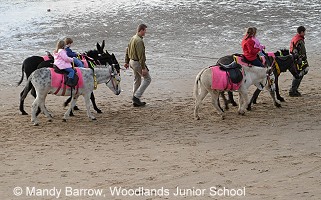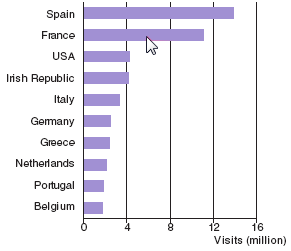 Project Britain
Project Britain
British Life and Culture
by Mandy Barrow
- Search our Site
- Project Britain
- Calendars
- Facts and figures
- London
- Great Britain
- Union Flag
- A-Z of Britain
- Customs & traditions
- Britain today
- Daily Life
- Money
- Etiquette
- Monarchy
- Government
- Education
- Tourist Information
- Food and drink
- Sports and leisure
- History
- Kings and Queens
- Superstitions
- Glossary
|
Where do British people go on their holidays?
|
|
|
Two-thirds of all British people have their holidays in July and August, which are the most popular months for holidays. English school children are on holiday from the end of July to the beginning of September. Traditional Holidays
The traditional British holiday is a seaside holiday. Children used to watch a Punch and Judy show (puppets) and ride donkeys along a beach.
Many British people spend much of their free time during the summer months down by the sea. Children enjoy swimming in the sea and building sandcastles. There are places near the sea, such as Blackpool, Scarborough and Bournemouth, where there is plenty to do even if it rains. Holidays Abroad
Europe is the most popular destination for UK residents, accounting for 80 per cent of visits abroad. Spain has been the most popular country to visit since 1994, with 13.8 million visits in 2005. France was second in popularity, with 11.1 million visits. The number of visits by UK residents to the USA increased by 2 per cent in 2005 to 4.2 million, 6 per cent higher than the number in 2001. The number of visits abroad made by UK residents has more than tripled since 1985, to a record 66.4 million visits in 2005. Holiday trips abroad 1971 - 6.7 million 2005 - 66.4 million Two-thirds of these visits abroad are holidays with about half (47 per cent) package holidays. Source: International Passenger Survey, Office for National Statistics TOP Destinations for British tourists 2005 The five countries to which UK residents made the most visits in 2005 remained unchanged from 2004. These were Spain (13.8 million visits in 2005), France (11.1 million visits), USA (4.2 million visits), Irish Republic (4.2 million visits) and Italy (3.4 million visits). The next five countries also remained unchanged from 2004; Greece, Germany, Netherlands, Portugal and Belgium.
Preferred mode of transport to holiday destinations
Popular holiday trends
A Timeline of British Holiday Habits 1800-1850 Ordinary working people only had holidays on ‘holy’ days (Sundays, Christmas, Easter)
The creation of a national railway system helped ordinary people travel. Most holidays were day trips to the British seaside by train.
Most Britons started to take a short Summer holiday for a week. Camping and holidays in caravans became popular in the 60s as people started to buy cars. British holiday camps were popular.
1970s
Skiing holidays were starting to become popular and the package industry continued to expand. British tourists started to prefer a package holiday abroad to an expensive British holiday
Packages to the USA became much cheaper than trips to British
resorts.
1990s - 2007 Other pages on a similar theme. |
|
 © Copyright - please read © Copyright - please read All the materials on these pages are free for homework and classroom use only. You may not redistribute, sell or place the content of this page on any other website or blog without written permission from the Mandy Barrow. |
© Copyright Mandy Barrow 2014
Mandy is the creator of the Woodlands Resources section of the Woodlands Junior website.
The two websites projectbritain.com and primaryhomeworkhelp.co.uk are the new homes for the Woodlands Resources.
Mandy left Woodlands in 2003 to work in Kent schools as an ICT Consultant.
She now teaches computers at The Granville School and St. John's Primary School in Sevenoaks Kent.
Woodlands Junior Homework Help new website







 1850-1900
1850-1900  1900-1960s
1900-1960s The airline industry expanded and tour operators started to offer very cheap package holidays to Spain or ‘last minute’ cheap fares. Large numbers of UK residents started to go abroad for their holidays. The package holiday boom started.
The airline industry expanded and tour operators started to offer very cheap package holidays to Spain or ‘last minute’ cheap fares. Large numbers of UK residents started to go abroad for their holidays. The package holiday boom started.  1980s
1980s  1980s-1990s
1980s-1990s A second yearly holiday became possible with more and more cheap
packages. Holidays to Australia and more exotic locations became cheap
enough for many ordinary working people.
A second yearly holiday became possible with more and more cheap
packages. Holidays to Australia and more exotic locations became cheap
enough for many ordinary working people.